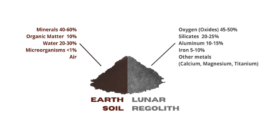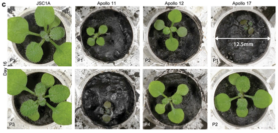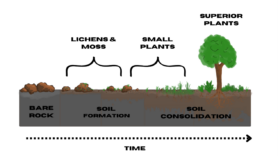Archief
Planting the Seeds of Space Exploration
NASA’s Artemis III mission is set to make history by growing plants on the moon. Scheduled for as early as September 2026, this mission will send four astronauts aboard the Orion spacecraft to the lunar surface. A key experiment, the Lunar Effects on Agricultural Flora (LEAF), will study how the moon’s environment affects plant growth, which could be crucial for providing food for future astronauts.
Whether astronauts are aboard a spaceship cruising the vastness of space or hunkered down on the moon or Mars, plants are essential for long-term space habitation. Not only do they provide food but also recycle carbon dioxide into oxygen, purify water, and manage waste—critical functions for sustaining life in space.
The Challenge of Lunar Soil
The safest bet for life support in long space travels is the use of Biological Closed Life Support Systems (BCLSS). These systems use a series of interconnected bioreactors —sophisticated tanks hosting bacteria, algae, and plants— that convert astronauts’ waste into clean air, water, and food. Unlike traditional agriculture, these systems don’t depend on soil. But if there is something on the moon, is dust and soil. So why not use it?
Lunar soil, named regolith —from the Greek “rhegos” meaning blanket, and “lithos” meaning rock— is not like Earth’s soil. Regolith is composed of fine, sharp glass particles formed by meteorite impacts over millions of years. It lacks the organic matter, living organisms, and moisture found in Earth’s soil.

The short answer to why not use regolith is that plants are not too fond of that environment. The sharp particles damage their roots, and the salts and metals in its composition are toxic to them. In essence, the moon is barren and extremely hostile to life. But so are some places on earth, where life has adapted to grow on similarly hostile conditions. These extremophile organisms —literally meaning “lovers of the extreme” in greek— seem to do just fine. Could we help plants thrive on the moon?
To that question, Jai Grover, Scientific Coordinator of the Advanced Concepts Team (ACT) at European Space Agency (ESA), stated, “Rather than whether or not life can thrive on the moon, the question is if we can build the environment with the right conditions for life.”
Lessons from Previous Attempts
The good news is that plants do sprout on the moon surface.
In the year 2019, the Chinese Space Agency successfully sprouted cotton, rapeseed, and potato seedlings on the moon inside the Chang’e-4 lunar lander. However, these seedlings died due to a thermal control failure that exposed them to the extreme cold of the lunar night, which can drop to minus 170 degrees Celsius.
We also know that plants actually grow on lunar regolith.
More recently, Anna-Lisa Paul et al. (2022) from the USA published a groundbreaking paper experiments using lunar samples brought back by the Apollo missions 11th, 12th and 17th back in 1969 and 1972. These studies involved germinating and growing the plant Arabidopsis thaliana in the regolith. The results showed that plants grow on this substrate. The plants grew, showing signs of severe stress induced by the lunar regolith’s chemical and physical composition. So, we learned that plants, although severely stressed, could actually grow on the moon.

From Paul, A.-L., Elardo, S. M., & Ferl, R. (2022). Plants grown in Apollo lunar regolith present stress-associated transcriptomes that inform prospects for lunar exploration. Communications Biology, 5(1), 382. https://doi.org/10.1038/s42003-022-03334-8, used under Creative Commons CC-BY 4.0 Open Access license.
The future LEAF experiment features a growth chamber for more plant species —Brassica rapa, Wolffia (duckweed), and Arabidopsis thaliana—. These plants will be shielded from the vacuum of space and the cold, harsh lunar environment. A novelty of this mission is also the plan to bring the seedlings back to Earth. This will allow scientists to study precisely how lunar conditions affected their growth.
Building a Sustainable Ecosystem
The idea of making life thrive on the moon involves more than just planting seeds. Grover and his team at ESA are working on the Artificial Primary Succession in Lunar Regolith project, which explores how life could settle on the moon. This project is inspired by how life colonizes new volcanic islands on Earth—initially barren rock that gradually supports lichens, mosses, and eventually complex plants, that successively weather down the rock into soil. This process is called Primary Ecological Succession.

Grover described this as a “brute force approach” to settling life on the moon. Simply shipping there enough materials to provide shelter, water, an atmosphere, and nutrients. With those ingredients, living organisms —most likely bacteria— will probably thrive. The new and huge SpaceX Starship rocket could make this possible in not too long.
There is, by contrast, an elegant approach, by which the ESA ACT team selects the best possible candidates to survive on lunar conditions based on research and data. Vitushanie Yogaranjan, a Young Graduate Trainee at ESA ACT, explains: “We’re trying to identify these very minimal ecosystems that can sustain themselves.” By using mathematical models, the team aims to predict the optimal combination of pioneer organisms that can utilize lunar resources effectively. The idea is to select the organisms that can establish a community, helping each other to survive the hardship.
The upcoming technical and scientific developments in the space industry are bringing the upcoming of lunar habitation closer to reality. In the advent of the new space era, these pioneering scientists are looking for inspiration in our biosphere to select the first ecological communities known to live outside of our planet.
Implications for Earth and Beyond
The significance of growing plants on the moon extends beyond space exploration. The knowledge gained from studying ecosystems in harsh lunar environments could help address food production challenges and mitigate climate change impacts on Earth. The seeds we plant on the moon may not only sustain future lunar missions but also nurture a greener, more sustainable future on our home planet.
In summary, the Artemis III mission and its LEAF experiment represent a significant step towards sustainable space exploration. By understanding how to grow plants in the challenging lunar environment, we take another step towards long-term human habitation beyond Earth and potentially find solutions that benefit our life here as well.
References for further reading:
[1] https://www.nasa.gov/mission/artemis-iii/ [2] https://spacelabtech.com/lunar-payload-leaf—lunar-effects-on-agricultural-flora.html [3]https://www.newscientist.com/article/2190704-first-moon-plants-sprout-in-chinas-change-4-biosphere-experiment/ [4] Paul, AL., Elardo, S.M. & Ferl, R. Plants grown in Apollo lunar regolith present stress-associated transcriptomes that inform prospects for lunar exploration. Commun Biol 5, 382 (2022). https://doi.org/10.1038/s42003-022-03334-8 [5] https://www.sciencealert.com/bacterium-lives-off-nuclear-energy-alien-life-europa [6] https://www.esa.int/gsp/ACT/projects/Artificial_Primary_Succession/
Written, edited and illustrated
by Álvaro Ropero
U moet ingelogd zijn om een reactie te kunnen plaatsen.

